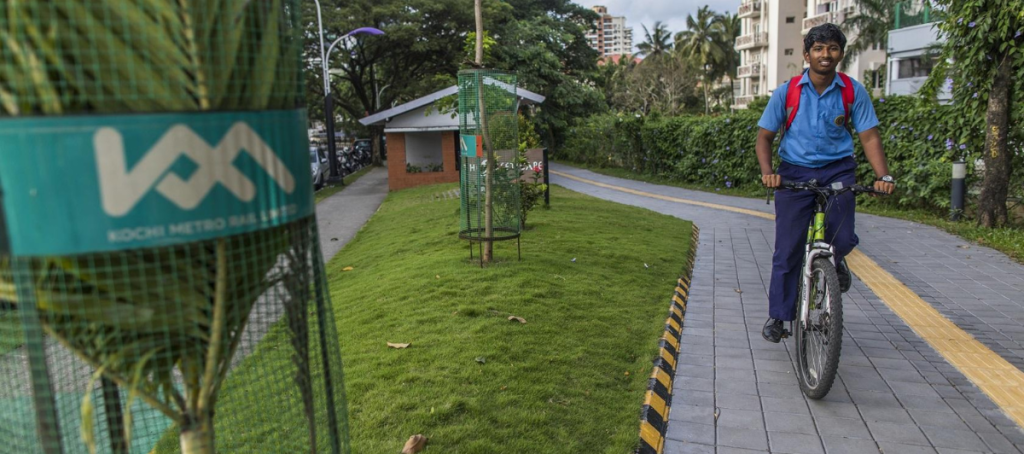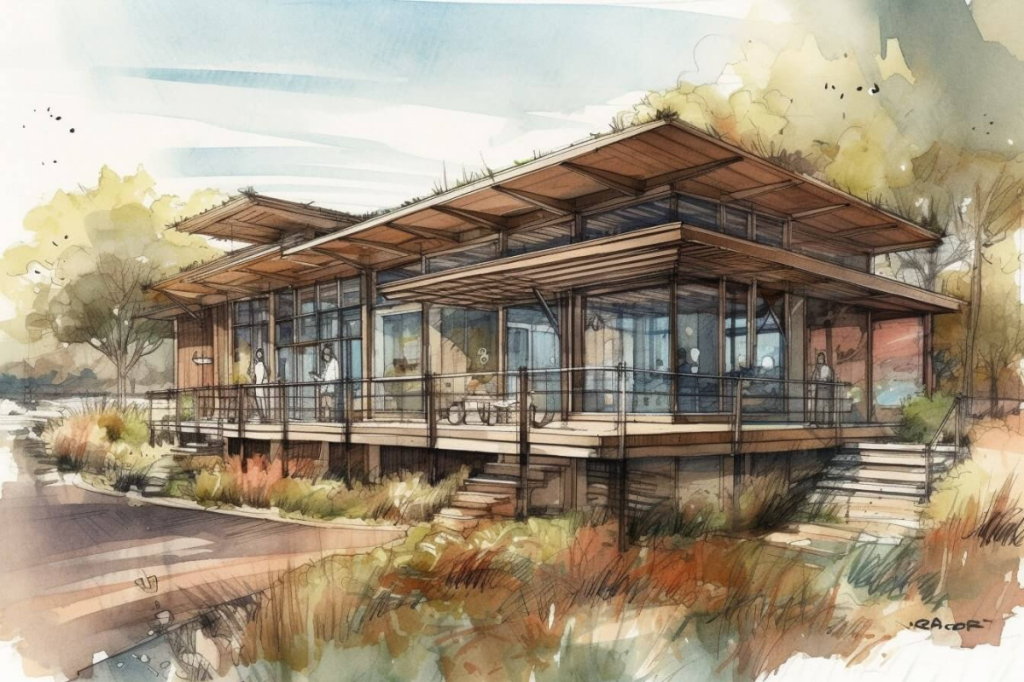Efficient Designs with Sustainability
Sustainable urban planning involves designing and organising cities to meet the needs of the present without compromising the ability of future generations to meet their own needs. Eco-cities are essential role models for sustainable building designs because they combine creative solutions for social, economic, and environmental issues.

Eco-cities and Sustainable Architecture
Eco-cities strongly emphasise integrated planning and design, considering many factors, including waste management, energy, water, transportation, and green areas. To step towards a green architecture India with sustainable building design in urban sectors, planners should take a comprehensive approach, dismantling conventional silos and encouraging collaboration across various sectors. Eco-cities prioritise parks, green areas, and sustainable landscaping to increase biodiversity, boost air quality, and lessen the impact of the urban heat island effect. To improve the standard of living and the sustainability of the environment, urban planners should set aside areas for green infrastructure, encouraging the development of parks, community gardens, and urban woods. In this regard, Indian sustainable architecture is making a considerable change within the Architectural Landscape of India.

Sustainable transportation eco-cities prioritise bicycle infrastructure, pedestrian-friendly surroundings, and effective public transit systems to lessen dependency on private automobiles. Urban planners should invest in public transit, infrastructure conducive to pedestrians, and bike lanes to encourage sustainable mobility and reduce transportation’s environmental impact, as we see happening in various cities of India as a plan to develop Indian sustainable architecture. For Energy Efficiency and Renewable Energy to lower carbon emissions and improve energy resilience, eco-cities combine energy-efficient technologies with renewable energy sources, such as solar and wind power. Urban planners should promote energy-efficient building designs, integrate renewable energy sources into city planning, and implement cutting-edge technologies to maximise energy use.
With an emphasis on waste reduction, recycling, and waste-to-energy solutions, eco-cities deploy efficient waste management systems which can be applied as a method for a green architecture India. To reduce the environmental impact of urban garbage, urban planners should prioritise waste reduction methods, put recycling systems into place, and investigate cutting-edge waste-to-energy technology.
Regarding Social Inclusion and Community Engagement, Eco-cities ensure that urban development satisfies the wide range of requirements of inhabitants by actively involving communities in the planning process. Building resilient and socially sustainable building designs require urban planners to stress inclusivity in decision-making processes, connect with local communities, and consider their opinions. Eco-cities take climate resilience into account when assessing resilience and adaptation. They also adjust to shifting environmental conditions and prepare for future obstacles like extreme weather occurrences. Urban planners can focus on disaster preparedness and eco-friendly buildings India can have. Also prioritising robust infrastructure to create communities that resist climatic changes.
Sustainable Building Designs in Urban Planning

Taking cues from eco-cities, sustainable urban development is essential from an environmental, social, and economic standpoint which can be used in India. Eco-cities emphasize ecological sustainability using waste management techniques, renewable energy sources, and green infrastructure towards a more green architecture India. Ecological footprints are minimized, carbon emissions are decreased, and natural resources are preserved with sustainable urban planning. This helps maintain biodiversity, enhance the air and water quality, and improve the general health of the environment.

In this discipline, mitigating and adapting to climate change are significant considerations. To meet these challenges, eco-cities integrate adaptive techniques with climate-resilient designs, and to reduce the effects of climate change, sustainable urban planning must reduce greenhouse gas emissions, improve urban resilience, and prepare cities for extreme weather and rising sea levels.
E-cities prioritise bicycle infrastructure, pedestrian-friendly surroundings, and effective public transportation systems to lessen dependency on private automobiles. Urban planners should invest in public transit, infrastructure conducive to pedestrians, and bike lanes to encourage sustainable mobility and reduce transportation’s environmental impact. To lower carbon emissions and improve energy resilience, eco-cities combine energy-efficient technologies with renewable energy sources like solar and wind power; urban planners should promote energy-efficient building designs, integrate renewable energy sources into city planning, and put cutting-edge technologies into practice to maximise energy use.
Conclusion
The inquiry of eco-cities as a source of priceless lessons for sustainable building design highlights the pressing need for revolutionary methods of urban development. As an initiative of Green Architecture India and across the world, the values and strategies embraced by these eco-cities can offer a guide for developing urban settings that are socially and economically inclusive as well as environmentally sensitive.
Beyond the conventional models, sustainable building design strongly emphasises integration, resilience, and a thorough comprehension of the interdependencies across diverse urban systems. The importance lies in reducing the adverse effects on the environment, providing urban dwellers with a high standard of living, encouraging community involvement, and creating the groundwork for the prosperity of future generations.
Adopting green infrastructure, sustainable transportation, renewable energy, and waste reduction strategies is crucial in the course of Indian Sustainable Architecture. This requires holistic thinking, wherein urban planners, policymakers, and communities work together to address the complex challenges of urbanisation.
The social aspect of sustainable urban planning also needs to be balanced; eco-cities prioritise social justice, community involvement, and cultural vibrancy because they understand that the happiness and well-being of the people who live there are intrinsically linked to the success of urban development. Cities worldwide may work to create socially and economically robust ecosystems and be environmentally sustainable by taking a cue from these examples.
Lessons from eco-cities point us toward a more sustainable and peaceful urban future during rising urbanisation and environmental concerns. Cities may break free from traditional development standards and usher in a new era of urban living that respects the environment, fosters community, and assures a prosperous legacy for future generations by embracing and modifying these ideas.
Motivated by the experience of eco-cities, sustainable building design and urban planning become apparent as a potent instrument for creating a future in which cities coexist peacefully with the environment.
Featured Image Credit: ugreen.io





